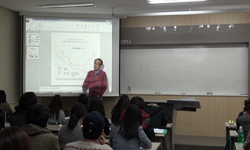본 연구는 지리정보시스템(GIS)과 지리적 가중 회귀(GWR)를 이용하여 건강 관련 삶의 질(HRQoL)의 사회인구학적 상관요인에 대한 공간분석을 시도한다. 관찰의 독립성과 오차의 동분산성을 가정...
http://chineseinput.net/에서 pinyin(병음)방식으로 중국어를 변환할 수 있습니다.
변환된 중국어를 복사하여 사용하시면 됩니다.
- 中文 을 입력하시려면 zhongwen을 입력하시고 space를누르시면됩니다.
- 北京 을 입력하시려면 beijing을 입력하시고 space를 누르시면 됩니다.

건강 관련 삶의 질의 사회인구학적 상관요인에 대한 공간분석 = A Spatial Analysis of Sociodemographic Correlates of Health Related Quality of Life
한글로보기https://www.riss.kr/link?id=A77002704
- 저자
- 발행기관
- 학술지명
- 권호사항
-
발행연도
2009
-
작성언어
Korean
-
주제어
삶의 질 ; EQ-5D ; 공간분석 ; 지리적 가중 회귀(GWR) ; 지리정보시스템(GIS) ; quality of life ; spatial analysis
-
등재정보
KCI등재
-
자료형태
학술저널
-
수록면
1-20(20쪽)
-
KCI 피인용횟수
18
- 제공처
- 소장기관
-
0
상세조회 -
0
다운로드
부가정보
국문 초록 (Abstract)
본 연구는 지리정보시스템(GIS)과 지리적 가중 회귀(GWR)를 이용하여 건강 관련 삶의 질(HRQoL)의 사회인구학적 상관요인에 대한 공간분석을 시도한다. 관찰의 독립성과 오차의 동분산성을 가정하는 전통적 회귀분석과 달리, 지리적 가중 회귀분석은 속성정보뿐만 아니라 공간정보를 활용하는 공간분석 기법이다. 분석모형은 건강 관련 삶의 질을 종합적으로 측정하는 EQ-5D를 종속변수로 하고 지역의 사회인구학적 특성인 노령인구비율, 조이혼율, 병상수, 재정 자주도를 독립변수로 하여 구성하였다. 종속변수는 질병관리본부에서 실시한 〈지역사회건강조사〉의 자료를 이용하였고, 독립변수는 통계청 온라인 DB에 수록된 지역별 자료를 이용하였다. 모형을 추정해 본 결과 전반적으로 사회적 특성보다는 노령인구비율이나 조이혼율과 같은 인구학적 특성이 건강 관련 삶의 질에 더 많은 영향을 미치는 것으로 나타났다. 공간적 변이를 고려하는 지역모형은 전역모형에서 드러나지 않았던 중요한 유형을 보여주는데, 노령인구비율 변수와 조이혼율 변수의 지역별 추정치를 지도상으로 살펴본 결과 변수들의 효과가 공간적 위치에 따라 차이를 보인다는 점이 확인되었다. 분석 결과는 또한 지리적 가중 회귀분석이 전통적 회귀분석에 비해 공간적 자기상관의 문제를 극복하고 모형의 부합도를 증가시킨다는 것을 보여준다.
다국어 초록 (Multilingual Abstract)
This study analyzes spatial variations of sociodemographic correlates of health related quality of life (HRQoL) using Geographical Information System (GIS) and Geographically Weighted Regression (GWR). Unlike the traditional OLS regression models whic...
This study analyzes spatial variations of sociodemographic correlates of health related quality of life (HRQoL) using Geographical Information System (GIS) and Geographically Weighted Regression (GWR). Unlike the traditional OLS regression models which assume independence of observations and homoscedasticity of errors, GWR is a spatial analysis technique which utilizes spatial information as well as attribute information. A model of HRQoL is estimated using GWR, where the EQ-5D index is the dependent, and ratio of old age, crude divorce rate, number of sickbeds per one thousand persons, and financial independence of local government are the independent. The EQ-5D index came from the Local Community Health Survey, and data for the independent variables came from National Statistical Office's online database. The results show that demographic variables such as ratio of old age and crude divorce rate are more important correlates of the HRQoL than social variables. The local model which incorporates spatial variations reveals important patterns which are not clear in the global model, showing that the effects of the independent variables are dependent on spatial locations. The results also demonstrate that GWR overcomes the problem of spatial auto-correlation and provides a better goodness-of-fit.
목차 (Table of Contents)
- Ⅰ. 서론
- Ⅱ. 지리적 가중 회귀분석의 논리
- Ⅲ. 모형과 자료
- Ⅳ. 분석과 논의
- Ⅴ. 요약 및 결론
- Ⅰ. 서론
- Ⅱ. 지리적 가중 회귀분석의 논리
- Ⅲ. 모형과 자료
- Ⅳ. 분석과 논의
- Ⅴ. 요약 및 결론
- 〈참고문헌〉
- ENGLISH ABSTRACTS
참고문헌 (Reference)
1 김두섭, "회귀분석: 기초와 응용(개정판)" 나남출판사 2008
2 성상석, "한국인에서 EQ-5D를 이용한 건강 관련 삶의 질 측정" 대한류마티스학회 11 (11): 254-262, 2004
3 이영균, "지역주민의 삶의 질에 관한 연구" 한국정책과학학회 11 (11): 223-250, 2007
4 김영오, "주민만족도 평가에 관한 실증적 연구" 한국정부학회 20 (20): 601-633, 2008
5 이영균, "시정부의 발전지표에 관한 연구" 한국지방행정연구원 22 (22): 79-116, 2008
6 구자문, "도시분석을 위한 인구주택센서스와 GIS 의 연계활용방안 연구-수치지도의 보완과 센서스트랙의 결정" 2 (2): 27-45, 1999
7 신인철, "기혼여성의 자녀출산계획에 대한 공간효과 분석" 한국인구학회 32 (32): 59-85, 2009
8 Economist, "http://www.economist.com/media/pdf/QUALITY_OF_"
9 Carlton, M. and A. S. Fotheringham, "http://ncg.nuim.ie/ncg/GWR/GWR_WhitePaper. pdf"
10 Carlton, M. and A. S. Fotheringham, "http://ncg.nuim.ie/ncg/GWR/GWR_Tutorial.pdf"
1 김두섭, "회귀분석: 기초와 응용(개정판)" 나남출판사 2008
2 성상석, "한국인에서 EQ-5D를 이용한 건강 관련 삶의 질 측정" 대한류마티스학회 11 (11): 254-262, 2004
3 이영균, "지역주민의 삶의 질에 관한 연구" 한국정책과학학회 11 (11): 223-250, 2007
4 김영오, "주민만족도 평가에 관한 실증적 연구" 한국정부학회 20 (20): 601-633, 2008
5 이영균, "시정부의 발전지표에 관한 연구" 한국지방행정연구원 22 (22): 79-116, 2008
6 구자문, "도시분석을 위한 인구주택센서스와 GIS 의 연계활용방안 연구-수치지도의 보완과 센서스트랙의 결정" 2 (2): 27-45, 1999
7 신인철, "기혼여성의 자녀출산계획에 대한 공간효과 분석" 한국인구학회 32 (32): 59-85, 2009
8 Economist, "http://www.economist.com/media/pdf/QUALITY_OF_"
9 Carlton, M. and A. S. Fotheringham, "http://ncg.nuim.ie/ncg/GWR/GWR_WhitePaper. pdf"
10 Carlton, M. and A. S. Fotheringham, "http://ncg.nuim.ie/ncg/GWR/GWR_Tutorial.pdf"
11 통계청, "http://gis.nso.go.kr" 통계청
12 질병관리본부, "http://chs.cdc.go.kr" 질병관리본부
13 LeGates,R, "Think Globally, Act Regionally: GIS and Data Visualization for Social Science and Policy Research" ESRI Press. 2005
14 WHOQoL Group, "The World Health Organization Quality of Life Assessment WHOQoL:Position Paper from the World Health Organization" 41 (41): 1403-1409, 1995
15 Tufte,E.R, "The Visual Display of Quantitative Information (2nd Edition)" Graphics Press. 2001
16 Löw,M, "The Constitution of Space: The Structuration of Spaces Through the Simultaneity of Effects and Perception" 1 (1): 25-49, 2008
17 Spilker B, "Taxonomy of Quality of Life In Quality of Life and Pharmacoeconomics in Clinical Trials(2nd ed)" Lippincott-Raven. 25-31, 1996
18 Griffith,D.A, "Spatial-Filtering-Based Contribution to a Critique of Geographically Weighted Regression(GWR)" 40 (40): 2751-2769, 2008
19 Hurvich, C. M, "Smoothing Parameter Selection in Nonparametric Regression Using an Improved Akaike Information Criterion" 60 (60): 271-293, 1998
20 Fox, J, "Regression Diagnostics Sage Unversity Paper Series on Quantitative Applications in the Social Sciences, 07-079" Sage Publications. 1991
21 Special Interest Research Group on Quality of Life, "Quality of Life:Its Conceptualization, Measurement, and Application"
22 Ferrans, C, "Quality of Life Index: Development and Psychometric Properties" 8 : 15-24, 1985
23 Berry, W. D, "Multiple Regression in Practice Sage Unversity Paper Series on Quantitative Applications in the Social Sciences, 07-050" Sage Publications. 1985
24 Burnham, K. P, "Model Selection and Multimodel Inference: A Practical Information-Theoretic Approach (2nd Edition)" Springer 2002
25 Warnecke, R, "Measuring Quality of Life in Culturally Diverse Populations" 20 : 29-38, 1996
26 Fotheringham, A. S, "Geographically Weighted Regression: the Analysis of Spatially Varying Relationships" John Wiley and Sons Ltd 2002
27 Brunsdon, C, "Geographically Weighted Regression: A Method for Exploring Spatial Nonstationarity" 28 (28): 281-298, 2002
28 DeMers, M. N, "Fundamentals of Geographic Information Systems (3rd Edition)" John Wiley & Sons. 2004
29 EuroQol Group, "EuroQol-a New Facility for the Measurement of Health-Related Quality of Life" 16 (16): 199-208, 1990
30 이영훈, "EuroQoL-5 Dimension 한국 가중치 모형의 적용 연구" 한국보건교육·건강증진학회 26 (26): 1-13, 2009
31 강은정, "EQ-5D를 이용한 건강수준의 가치 평가" 한국보건경제정책학회 12 (12): 19-43, 2006
32 Ferrans,C.E, "Development of a Quality of Life Index for Patients with Cancer" 17 (17): 15-19, 1990
33 Ferrans,C.E, "Development of a Conceptual Model of Quality of Life" 10 (10): 293-304, 1996
34 Kim, M. H, "Cross-Cultural Adaptation and Validation of the Korean Version of the EQ-5D in Patients with Rheumatic Diseases" 14 (14): 1401-1406, 2005
35 Lo, C. P, "Concepts and Techniques in Geographic Information Systems" Prentice Hall. 2002
36 Tobler,W.R, "A Computer Movie Simulating Urban Growth in the Detroit Region" 46 (46): 234-242, 1970
동일학술지(권/호) 다른 논문
-
- 한국인구학회
- 이선형(Sun Hyung Lee)
- 2009
- KCI등재
-
연령이 인구이동에 미치는 영향 : 최초이동, 계속이동, 귀환 이동
- 한국인구학회
- 이상림(Sanglim Lee)
- 2009
- KCI등재
-
- 한국인구학회
- 조성남(Sung-Nam Cho)
- 2009
- KCI등재
-
- 한국인구학회
- 최혜지(Hyeji Choi)
- 2009
- KCI등재
분석정보
인용정보 인용지수 설명보기
학술지 이력
| 연월일 | 이력구분 | 이력상세 | 등재구분 |
|---|---|---|---|
| 2027 | 평가예정 | 재인증평가 신청대상 (재인증) | |
| 2021-01-01 | 평가 | 등재학술지 유지 (재인증) |  |
| 2018-01-01 | 평가 | 등재학술지 유지 (등재유지) |  |
| 2015-01-01 | 평가 | 등재학술지 유지 (등재유지) |  |
| 2013-01-01 | 평가 | 등재 1차 FAIL (등재유지) |  |
| 2010-01-01 | 평가 | 등재학술지 유지 (등재유지) |  |
| 2008-01-01 | 평가 | 등재 1차 FAIL (등재유지) |  |
| 2006-01-01 | 평가 | 등재학술지 유지 (등재유지) |  |
| 2004-01-01 | 평가 | 등재학술지 유지 (등재유지) |  |
| 2001-07-01 | 평가 | 등재학술지 선정 (등재후보2차) |  |
| 1999-01-01 | 평가 | 등재후보학술지 선정 (신규평가) |  |
학술지 인용정보
| 기준연도 | WOS-KCI 통합IF(2년) | KCIF(2년) | KCIF(3년) |
|---|---|---|---|
| 2016 | 1.34 | 1.34 | 1.65 |
| KCIF(4년) | KCIF(5년) | 중심성지수(3년) | 즉시성지수 |
| 1.86 | 2.07 | 2.564 | 0.4 |





 ScienceON
ScienceON DBpia
DBpia







